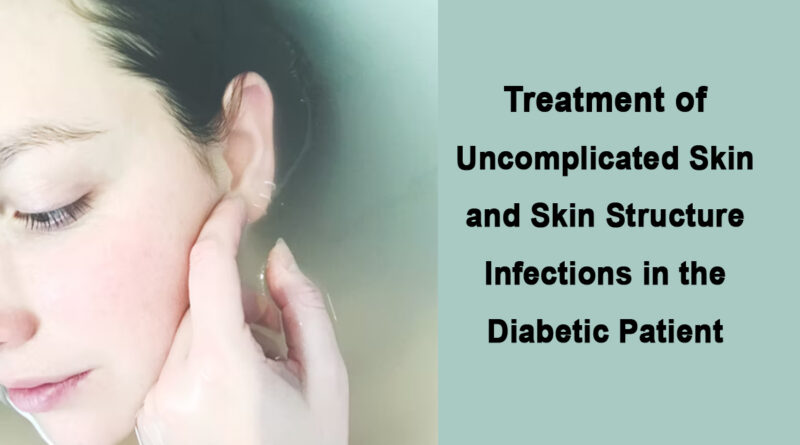Treatment of Uncomplicated Skin and Skin Structure Infections in the Diabetic Patient
Diabetic neuropathy can lead to the development of ulcers on the lower extremities. Prompt treatment lowers the likelihood of infection and reduces the probability that an established infection will lead to amputation. Antibiotics are selected on the basis of the suspected organism and the level of infection. Unnecessary antibiotic prophylaxis is discouraged because it increases the likelihood that bacterial resistance to the antibiotic agent will develop. Culture samples must be taken by curettage of biopsy rather than by swabbing to assure detection of pathogens.
Introduction
In the United States, foot infection is the leading cause of both diabetes-related hospitalization (1) and lower-extremity amputation. (2-4) More than 90% of cases of osteomyelitis of the foot are associated with infected foot ulcers. The American Diabetes Association estimates that almost 90,000 lower extremity amputations secondary to diabetes are performed each year. In 85% of amputations, ulceration is a pre-disposing factor. The 5-year survival rate of unilateral diabetic amputees is 50%; for bilateral amputees, the rate drops to 0%.
Lower-extremity neuropathy associated with diabetes mellitus often leads to the development of uncomplicated skin and skin structure infections (uSSSIs) (Figure 1). Untreated, uSSSIs may develop into complicated infections (Figure 2). Long-term survival of diabetic patients depends on the recognition and proper treatment of uSSSIs before they develop into more serious conditions that warrant amputation. This article focuses on the treatment of uSSSIs in diabetic patients.
Check out these related articles, too:
Best Tips For Healthy Eating With Diabetes
Specific Exercises You Can Use As a Natural Diabetes Treatments
What is The Easiest Way To Manage Diabetes?
The Meaning of Your Blood Sugar Numbers
Effective Natural Remedies For Diabetes
Classifying the Diabetic Wound
Proper classification of the diabetic wound is essential before selecting treatment. Diabetic foot infections are divided into 4 categories of severity: non-infected, mild, moderate, and severe. (5)
Non-infected ulcers are characterized by granulation of the tissue base, shallow tract, the absence of cellulitis and pus, and normal serous drainage. The wound is likely to be contaminated or colonized by bacteria but there are no signs of infection.
Mildly infected ulcers have 2 or more manifestations of inflammation (purulence, erythema, tenderness, pain, induration, warmth) and cellulitis or erythema that extends 2 cm or less around the ulcer. The infection is restricted to skin and superficial subcutaneous tissues. This type of wound is usually local and patients have no systemic illness or other complications.
Moderately infected ulcers have one or more of the following characteristics: cellulitis greater than 2 cm; lymphangitic streaking, location beneath superficial fascia; gangrene; abscess of deep tissue; and muscle, tendon, bone, or joint involvement. The patient is metabolically stable and systemically well, although white blood cell counts or glucose levels may change and require treatment. If located in the foot or limb, wounds of this type may eventually lead to amputation.
Severely infected ulcers have the characteristics of moderate infection plus one or more additional factors–signs or symptoms of sepsis, significant metabolic imbalance, severe peripheral vascular disease, or combinations of these. Severe diabetic infections are life-threatening. In diabetic patients, uSSSIs comprise only non-infected and mildly infected wounds.
Treatment of Diabetes-Related uSSSIs
Diabetic wound treatment requires debridement, offloading, and antibiotics in that order. Antibiotics alone will not heal a diabetic wound. Debridement (Figure 3) promotes healing by creating an acute wound. By removing necrotic tissue and bacteria, debridement establishes a basis for wound healing, allows more accurate visual assessment, promotes the influx of growth factors and platelets, and reduces the level of matrix metalloproteinases (MMPs). MMPs have been shown to degrade growth factors.
Offloading the pressure causing the wound inhibits inflammatory stimuli and allows the wound to heal. Chronic inflammatory stimuli (ie, pressure and infection) delay wound healing by increasing MMPs and decreasing the entry of endogenous growth factors. The inflammatory cascade begins with the causative pressure and may continue when infecting agents are introduced. This leads to increased activity of neutrophils and macrophages, increased production of TNF-[alpha] and IL-lb, and increased MMP production.
Wound care products can be used to interrupt the inflammatory cascade (Regranex Gel, 0.01%) or reduce MMPs (Promogran) in the chronic wound environment. If infection is present, the appropriate administration of antibiotics in important. The use of prophylactic antibiotics, however, is not based on scientific data and does not accelerate healing.
Antibiotics for the Infected Ulcer
Diabetic wound infections are often not polymicrobial as was previously thought. The responsible organisms are usually Gram-positive pathogens such as Staphylococcus aureus or group B streptococci. (6-9) In diabetic ulcers, S. aureus may occur as methicillin-susceptible S. aureus (MSSA) or methicillin-resistant S. aureus (MRSA). Community-acquired MRSA is becoming more common. Isolates in mild diabetic infections are shown in Figure 4.Because virtually all strains of S. aureus found in lower extremity infections produce [beta]-lactamase, empiric treatment of suspected S. aureus infections always includes a [beta]-lactamase-stable antibiotic (eg, a cephalosporin).
Mild diabetic infections are caused most often by staphylococci and streptococci. [beta]-Lactamase-stable antibiotics are appropriate empiric choices for these infections. In moderate to severe infections, causative agents include S. aureus (MSSA or MRSA), group B streptococci, Gram-negative organisms (Pseudomonas species are still uncommon), anaerobic bacteria (Gram-positive and Gram-negative), and Enterococcus species.
More severe infections are best treated with [beta]-lactamase inhibitors (eg, ampicillin/sulbactam with or without a quinolone), clindamycin plus an agent effective against Gram-negative pathogens, broad-spectrum quinolones, or linezolid.
A Note About Culturing
Bacteria exist in wounds at 3 levels: contamination, colonization, and infection. A wound is contaminated when bacteria are present but not multiplying. In colonization, bacteria are present and multiplying. In infected wounds, bacteria are present, multiplying, and eliciting a host response.
Because all diabetic ulcers are colonized by a variety of bacterial species, cultures of superficial swabs usually reveal multiple species (10) that may or may not be pathogenic. There is little compelling evidence that this bioload inhibits wound healing.
Evidence exists that ulcers may heal without antibiotics. (11) When physicians receive positive culture results from an ulcer lacking overt signs of infection, they may nevertheless prescribe antibiotics as a supplement to standard wound therapy. This issue was addressed in a 1996 study of Chantelau and colleagues. (11) Forty-four diabetic patients with uncomplicated neuropathic foot ulcers were given
andard treatment consisting of pressure relief, daily wound cleansing, and sterile dressings. All but one ulcer was infected. Patients were randomized to receive either amoxicillin and clavulanic acid or placebo. The results indicated no significant difference in healing between the 2 groups. The authors concluded that antibiotic treatment with amoxicillin and clavulanic acid in addition to standard wound care provided no additional benefit in uncomplicated neuropathic foot ulcers of diabetic patients.
Physicians may be concerned about the medico-legal implications associated with not prescribing antibiotics when positive culture results appear on the chart of a patient with a clinically non-infected wound. If they prescribe an inappropriate antibiotic to avoid potential litigation, however, the cost of treatment will increase and the possibility of adverse events (eg, development of resistant strains) will be introduced.
If culturing is necessary, the area is first cleansed thoroughly with antiseptic (eg, Betadine) and rinsed with sterile saline or water. Of critical importance is that culture samples be taken by curette or biopsy from the ulcer base where infectious agents reside, rather than by swabbing the surface. (7,8)
Topical Antimicrobials
Although studies show the topical antimicrobials in diabetic foot ulcerations lack efficacy, most clinicians prescribe them regularly. Commonly used agents include mupirocin, silver compounds, povidone-iodine, gentamicin-triple antibiotic preparations, and fusidic acid.
Mupirocin is FDA-cleared for the treatment of impetigo and pyoderms, but is often used off label to treat ulcers because of its effectiveness against Gram-positive organisms. Silver compounds (eg, silver sulfadiazine) are broad-spectrum antimicrobials whose usage in wound healing is increasing rapidly, especially in the treatment of venous stasis ulcers. Usage of silver compounds is supported by anecdotal case studies.
In vitro culture studies suggest that povidone-iodine antiseptic may be toxic to tissue, but in vivo toxicity in wounded tissue has not been shown. Fusidic acid is a potent antistaphylococcal drug available in both topical and oral preparations. It is available only in Europe and Canada.Diabetic Skin care,Select Medical Products, Diabet-X Body Wash, FNC Medical, Diabet-x Skin Care
Conclusions
Antibiotics for d iabetic foot infections are chosen on the basis of suspected pathogens and class of infection. Since mild infections are most often caused by staphylococci and streptococci, cephalosporins are the treatment of choice for initial therapy. To optimize compliance, antibiotic dosing should be as infrequent as possible, especially in patients taking multiple medications. Antibiotics should be changed or continued on the basis of culture and sensitivity test results.
Disclosure: Dr. Rich received an honorarium from Abbott Laboratories for her presentation.
References
1. Smith DM, Weinberger M, Katz BP. Predicting non-elective hospitalization: a model based on risk factors associated with diabetes mellitus. J Gen Intern Med. 1987;2:168-173.
2. Lipsky BA. Infectious problems of the foot in diabetic patients. In: Bowker JH, Pfeifer MA, eds. The Diabetic Foot. 6th ed. St. Louis, Mo; Mosby; 2001:467-480.
3. Reiber GE. Epidemiology of foot ulcers and amputations in the diabetic foot. In: Bowker JH, Pfeifer MA, eds. The Diabetic Foot. 6th ed. St. Louis, Mo; Mosby; 2001:13-32.
4. Currie CJ, Morgan CL, Peters JR. The epidemiology and cost of inpatient care for peripheral vascular disease, infection, neuropathy, and ulceration in diabetes. Diabetes Care. 1998;21:42-48.
5. Lipsky BA, Berendt AR, Deery HG, et al. Diagnosis and treatment of diabetic foot infections. Clin Infect Dis. 2004;39:885-910.
6. Jones EW, Edwards R, Finch R, et al. A microbiologic study of diabetic foot lesions. Diabetic Med. 1984;2:213-215.
7. Lipsky BA, Pecoraro RE, Wheat LJ. The diabetic foot. Soft tissue and bone infection. Infect Dis Clin North Am. 1990;4:409-432.
8. Caputo GM, Cavanagh PR, Ulbrecht JS, Gibbons GW, Karchmer AW. Assessment and management of foot disease in patients with diabetes. N Engl J Med. 1994;331:854-860.
9. Armstrong DG, Liswood PJ, Todd WF. 1995 William J. Stickel Bronze Award. Prevalence of mixed infections in the diabetic pedal wound. A retrospective review of 112 infections. J Am Podiatr Med Assoc. 1995;85:533-537.
10. Louie TJ, Bartlett JG, Tally FP, Gorbach SL. Aerobic and anaerobic bacteria in diabetic foot ulcers. Ann Intern Med. 1976;85:461-463.
11. Chantelau E, Tanudjaja T, Altenhofer F, Ersanli Z, Lacigova S, Metzger C. Antibiotic treatment for uncomplicated neuropathic forefoot ulcers in diabetes: a controlled trial. Diabet Med. 1996;13:156-159.
Article Source: http://EzineArticles.com/1493131




